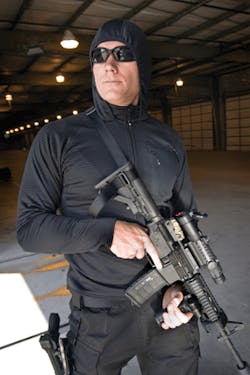Historically, the amount of time and thought put into a uniform design was not in keeping with the ratio of hours an officer ends up spending in it. Modern uniform technology has some praises to sing however. Today's manufacturers are listening to what officers have to say and in turn, making more wear-, fit-, comfort- and movement-friendly attire that satisfies the need for a consistent, professional look while catering to the daily wear needs of the man or women underneath.
A vision in blue
When two California officers were fed up with their uniforms' shortcomings, they decided to do something about it.
John Wilson, an officer for eight years with additional experience in fire, forest service and the military, has been wearing government-issued uniforms since 1993. He and his partner began by tweaking their department utility uniform (which was not a 5.11 product). By coincidence 5.11 Tactical's president, Dan Costa, heard about the officers' vision and zest for reforming uniforms, and he invited them to share their insights and ideas with the company. Wilson explains Costa even went so far as to bring them into a factory workroom, hand over design tools and supplies and say, "OK, now's your chance." That's the beginning of how Wilson, his partner and 5.11 embarked on putting together what Wilson calls the "Jack of all trades" uniform and what 5.11 calls its Patrol Duty Uniform.
"They had a lot of ideas about how the uniform could be improved," says David Hein, director of merchandising and apparel for 5.11 with 20 years industry experience in uniform and consumer apparel.
Characteristically not bashful about picking apart the problems they have with current uniforms, law enforcement personnel have struggled for years to create the ideal pieces: tops that breathe well, truly fit and can accommodate the equipment police must carry. To these ends, 5.11's PDU shirts feature a mic-cord pass-through just above the duty belt, hidden document pockets, pen slots, a zip placket with faux buttons, epaulets, underarm vents and adjustable wrist cuffs.
Administrators also want a traditional, professional look and tone that some tactical and military styles lack. Hein says the PDU addresses what the chief or the commissioner and what the patrol officer require.
"There's a fine line you've got to walk between those two because you want something that's comfortable, that's durable and that'll do and perform as the officer wants, but you also want something that makes them look good in public, like their commissioner or the chief wants," he explains. "The PDU gave us the ability to provide that."
Among the visionary officers' requests was an expandable comfort waist, and for the women's version a more natural waistline as well. The end-result pants feature flat-front styling, permanent creases and hidden pockets throughout. Notably, the PDU is a wash-and-wear outfit; no dry cleaning is required and the Teflon (fluorine-containing resin)-treated material not only holds its color throughout its life cycle despite home laundering; it's specially sewn creases come out of the dryer unspoiled, not requiring extra pressing, Hein and Wilson say.
Further, the modifiable waist takes the ebb and flow of human waistline and environmental conditions into consideration. Other traditional uniform pants are fitted and not forgiving, causing discomfort, and in some cases, risk to the wearer.
"[Ill-fitting pants can cause] a bunching effect that can create an injury. It bruises the hips and causes a red or purple mark after wearing your belt for 12 or 14 hours," Wilson says. "If I gain weight, it's almost worse because now you have pressure on your bladder and your stomach area along with the belt and it hurts all day long. If you have to jump over a fence, it could lead to an injury, a hernia, something else. And that's just for a man who happens to go through a weight change." 5.11 also offers a truer fit for women that has a rise allowing the duty belt to rest in a more natural position.
Built-in tourniquets
Another uniform offering is borrowed from a cousin industry to improve upon traditional duty wear. Developed for the "high-speed" law enforcement mission — for SWAT and hostage rescue team-type ops — Blackhawk's High Performance Fighting Uniform (HPFU) was adapted from a similar design made for the U.S. Navy Seals. The HPFU system includes pants, jacket and combat shirt with a layered vest made of a no-melt, no-drip nylon/cotton blend, with a fire-resistant material on the shirt torso.
Terry Naughton, vice president of marketing, explains one of the most important developments within the HPFU is the eight tourniquets built into the uniform and positioned in areas of major arteries on the body. "Soldiers had told us and what studies had shown was that the No. 1 cause of death in the battlefield was extremity bleeding," Naughton says. "While everybody was issued a tourniquet, they couldn't always apply it in time to save their own lives. So we took all their feedback and we made those changes."
In addition to the SWAT-style uniform, Blackhawk has recently revealed a jacket system. Naughton says the company borrowed some features from the outdoor market to create warm layers that provide maximum comfort, mobility and performance in cool weather. Thumb holes on the cuffs ensure no gaps between glove and sleeve and make for more efficient layering.
"The most basic function of a thumb hole is to allow you to put the jacket over it easier," Naughton explains. "Like a little kid, when you go to put your jacket on, you pull your sleeve down and then you hold it with your fist. When you have thumb holes you don't have to worry about that. It helps you get the jacket on easier." The new Warrior Wear jacket lineup includes the Grid Fleece Series, the Thermo-Fur Jacket, the RAD Series Vests and the Fleece Liner for Blackhawk's Shell Jak Series.
Blackhawk plans to offer the HPFU in April.
Protection under fire
A significant number of agencies informed Tru-Spec by Atlanco that they could not afford to provide their SWAT teams with fire-resistant clothing; undoubtedly a truth known far and wide. This got the company's boilers turned up to full-blast. In response, Tru-Spec brought a fire-resistant aspect to law enforcement all the while remembering that officers prefer to be comfortable.
Within its X-Fire Series, the Interlock fabric is available as a Tactical Response Uniform (TRU) and a Flight Suit — with the Flight Suit designed mostly for airborne units. Interlock fabric is a fire-resistant material containing DuPont Nomex brand fiber and cotton combination to form a lightweight and cost-effective uniform, thus making it more comfortable than a full Nomex uniform.
"[When] SWAT officers are called out it could last an hour, it could last 14 hours," says Bob Grueskin of Grueskin Marketing Communications, spokesman for Tru-Spec. "It might be a shooter; it might be a bomb call or drug lab. He doesn't know what he's going to be involved in, so he can put this on and he'll be comfortable no matter what the circumstances."
The X-Fire Interlock cotton fabrics are treated with a fire-resistant chemical that locks in the flame-resistant properties. After a 100-wash test, the properties showed no loss of fire resistance with a 2-inch to 2.5-inch char length — the maximum distance of damage done by a flame to the fabric in tests.
The TRU features multiple loop-faced pockets, many using a hook-and-loop closure secured with YKK Powerhooks. Additional features include a bi-swing back, adjustable hook-and-loop cuff with zigzag stitching, a drawstring waist and leg ties, sleeve pen stalls, and a 1-inch-wide belt loop with a 2.25-inch opening.
Knowing the locker is already full of gear, Tru-Spec built in an interior stow bag for packing and a hanger loop near the collar of its fire-resistant X-Fire Flight Suit. As with its sibling, the suit comes with a multitude of pockets, including reinforced external elbow pockets for elbow pads, two large zippered upper chest pockets, a zipper cargo pocket and an extra-large calf zipper pocket.
Boxers or briefs?
Throughout Tru-Spec's Baselayer undergarment line, there are many common features such as ribbed knit collars with double needle cover stitching, a heat transfer tag and an off-set shoulder seam to minimize seam stacking. The Baselayer Crew and Mock Neck Long Sleeve shirts include ribbed knit cuffs with internal thumb loops for securing sleeves while layering.
Baselayer undergarments wouldn't be complete without boxer briefs or drawers. While including some of the same elements of their shirt counterparts, the undergarments incorporate an elastic waistband, and the boxer briefs feature a gripper on the exterior to secure an officer's tucked-in shirttail.
The science of waterproofing
Public safety professionals often find themselves wading through a host of wet, corrosive and downright dirty matter. That's why Magnum Boots USA made it a mission to get waterproofing down to a science using Ion Mask technology.
"Ion Mask was originally developed for the U.K. military by a company called P2i, and they wanted to get the technology to the general population," says Dayna Panales, public relations manager at Magnum. Hi-Tec, Magnum's sister company, was the first consumer-based company to launch Ion Mask in a shoe. The Elite Force 8.0 WPI boot with Ion Mask launched in the tactical field in 2009.
When applied to the boot, Ion Mask, a plasma-based technology, adheres to every single fiber — even the rubber, leather and shoe strings. Thanks to this impenetrable shield, any liquid the boot comes into contact with sits on the surface like mercury and rolls right off. For EMS and law enforcement workers especially that spells extra protection in all kinds of precarious situations.
"What makes this really cool — especially for the tactical field — is it makes the shoe pathogen-resistant," says Panales. Say an officer walks into a puddle of blood and the stitching on his footwear is not treated with any type of waterproofing technology. The blood proteins can begin to deteriorate the threads. Ion Mask coats the threading as well as the entire shoe, so every square inch is waterproof up to the tongue.
In addition to being hydrophobic, Panales adds the boot is seem sealed and constructed of waterproof leather; the Ion Mask just creates an additional shell of armor.
The lightweight Elite Force WPI weighs 20 ounces in a men's size 9 and remains breathable. According to Panales, Ion Mask does not have to be reapplied, and lasts the life of the leather and to the fabric it's applied.
Hi-viz meets hi-style outerwear
All of Magnum's new outerwear and clothing is tested and reviewed by tactical and law enforcement professionals throughout the world. Panales adds, "We get every kind of opinion and ideas — where the pockets should be, the Velcro, what's keeping you undercover, that kind of thing." This is how the company came up with the Bi fit Elite and Reversible Hi-viz jacket. It's especially convenient for undercover officers who want a features-stacked yet stylishly stealthy piece of outerwear.
Users can carry gun magazines and other extras in the Bi fit's many pockets. This particular jacket also boasts an integrated vest system underneath, so it can be worn as a three-piece article of clothing. The under-vest has Velcro straps across the front chest and back, on which wearers can apply and produce a police label for quick identification.
Both pieces are designed to look neat, clean and sleek. "We wanted it to look like you're just wearing an urban setting jacket," says Panales. "But in the case of the hi-viz jacket, you turn it inside out and you are completely NC2 hi-viz reflective."
All jackets have detachable, zip-off or fold-up hoods. They also feature mic lube and zipper weapons access.
Keeping cool while concealed
With seven years in law enforcement under his belt, Ray Booska, CEO of CoolVest, knows what it's like to be uncomfortable beneath pounds of body armor. "The guys I went to school with and was in the army with, still in law enforcement, made a career out of complaining how hot it is," he recalls. "Knowing that I make cooling vests for 13 years [they said] 'Well, why can't you make something that we can use with body armor?' "
Because concealable body armor fits the body so closely and tightly, adding an additional cooling vest is liable to restrict an officer's movement and get in the way. "You really couldn't do it," says Booska. "It might work out for the guys sweating in Iraq, but a cooling vest under concealable armor is more of a trick when outfitting a regular road cop." To make it work, Booska did away with the concept of a separate cooling vest, and instead fashioned cooling panels that fit underneath any brand of armor, so that armor doesn't have to be modified.
Booska began making the Cool Armor about three years ago when a government contact requested an accessory to body armor that would provide cooling for special purposes. "We sort of went from there and turned it into a consumer product," recalls Booska.
To get a cool feel — even under concealable armor — users can insert the cooling panels into the side of a rectangular cloth carrier that fits to the body with elastic straps and Velcro. The elastic straps come out the arm holes on the body armor, and the unit attaches to itself outside the front of the chest.
"Some people wear them in the front and the back; some people just wear it in the front … it's a personal preference," says Booska. Law enforcement officers who seek extra comfort on duty can even prepare a couple panels the night before their shift, throw them in a cooler in the trunk of their car and swap them out throughout the day. According to Booska, the panels take about 15 minutes to recharge and offer hours of on-the-job temperature control.
Shared burden
Designing uniform attire could create fish-in-a-barrel circumstances, since wearers frequently have little say or choice. An officer's uniform shouldn't be a great burden on his or her back. Thankfully, modern uniform manufacturers are taking note of what end-users call for and what management requires and as a result, creating options that meet needs on both ends.
No matter the form of the uniform, manufacturers emphasize that they take their task seriously to lift that burden.

Jonathan Kozlowski
Jonathan Kozlowski was with Officer.com, Law Enforcement Technology, and Law Enforcement Product News from August 2006 to 2020.
As former Managing Editor for Officer Media Group, he brought a dedicated focus to the production of the print publications and management of the Officer.com online product and company directory. You can connect with Jonathan through LinkedIn.
Jonathan participated as a judge for the 2019 and 2020 FOLIO: Eddie & Ozzie Awards. In 2012, he received an APEX Award of Excellence in the Technology & Science Writing category for his article on unmanned aerial vehicles (UAVs) in police work, aptly titled "No Runway Needed".
He typically does not speak in the third person.

Tabatha Wethal | Editor
Award-winning writer Tabatha Wethal is a previous editor leading Law Enforcement Technology magazine and assisted with other publications. She was with the magazines since 2007.



